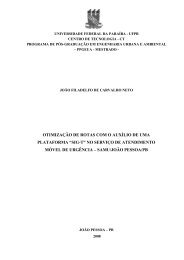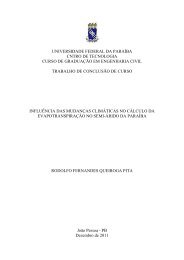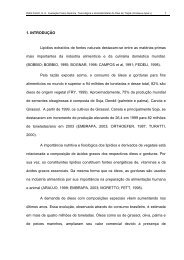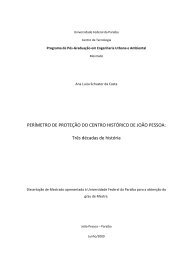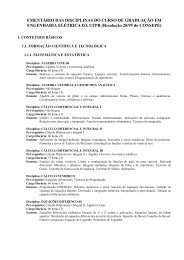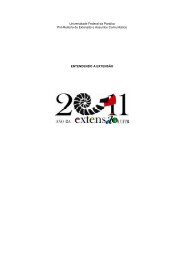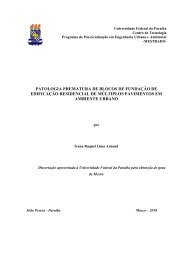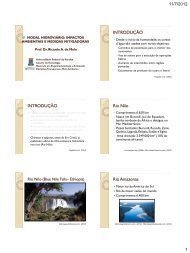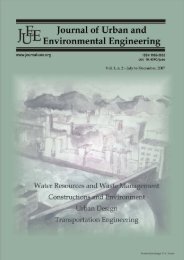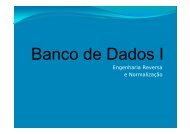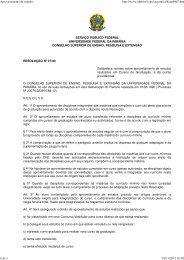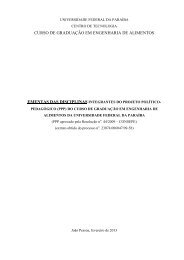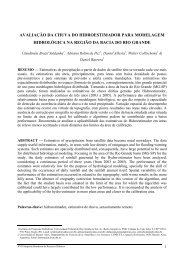Mensuração e avaliação dos custos ocultos no setor de ... - CT-UFPB
Mensuração e avaliação dos custos ocultos no setor de ... - CT-UFPB
Mensuração e avaliação dos custos ocultos no setor de ... - CT-UFPB
Create successful ePaper yourself
Turn your PDF publications into a flip-book with our unique Google optimized e-Paper software.
ABSTRA<strong>CT</strong><br />
The objective of this thesis is to combine management tools to i<strong>de</strong>ntify, measure and<br />
evaluate the costs of industrial maintenance activity in an mining industry, in or<strong>de</strong>r to<br />
verify the existence of hid<strong>de</strong>n costs. The methodology is based on three aspects. The<br />
first was the use the FMEA tool in parallel with the cost tree as a <strong>de</strong>terminant for the<br />
classification of maintenance activities in or<strong>de</strong>r to i<strong>de</strong>ntify and separate activities<br />
according to the pre<strong>de</strong>termined classification: preventive replacement (SP), preventive<br />
restoration (RP), predictive inspection (IP), functional inspection (IF), operational<br />
service (OS), corrective maintenance (CM), functional repair (RF). The classification<br />
obtained by the FMEA was used as director of the cost measurement by the RKW<br />
costing system. The second aspect consisted in calculating the maintenance activities<br />
by two ways. The first of them is based on the conventional term Cman = CMAT +<br />
CMO + CFer + Cinv (formula 2, where Cman is maintenance cost, CMAT = material<br />
cost , CMO = labor force cost, CFer = tooling costs and Cinv = investment costs) . The<br />
second is represented by the formula Cman = CP + CC + Cf (Cman = maintenance<br />
cost, CP = cost with prevention activities, CC = cost with corrective activities and Cf =<br />
cost due to failure) proposed by Almeida (2001). To use the formula Cman = CP +<br />
CC + Cf was required the <strong>de</strong>velopment of the terms that allow the calculation of the<br />
term Cf, with the i<strong>de</strong>ntification of the hid<strong>de</strong>n costs from activities qualitatively classified<br />
and associated to costs of <strong>no</strong>n quality (CNQ ) and costs of low productivity (CPD). The<br />
third and final point was characterized by the use of Life Cycle Cost (LCC) to check<br />
the impact of the two ways of calculating the costs of maintenance in four situations<br />
presented and customarily experienced in day-to-day maintenance, that are: to<br />
continue providing maintenance, reform partially or completely the existing equipment<br />
or replace the equipment for a new one. Thus, we obtain the following final results: (1)<br />
the establishment of a classification <strong>de</strong>termined by the FMEA tool that allowed to<br />
i<strong>de</strong>ntify and measure in the maintenance activity the failure factor costs (Cf) and also<br />
be used new ways to calculate the maintenance activity and consequently associate<br />
with the measurement of hid<strong>de</strong>n costs in this activity. (2) Both, the conventional way of<br />
calculating the cost of maintenance and the form proposed by the formula Cman =<br />
CP + CC + Cf, should be used together and in a complement way; (3) the LCC tool,<br />
as the using of the two ways to calculate, has managed to rank the 4 situations,<br />
proposed in the following way: restore partially (situation 3), maintain the condition of<br />
the current maintaining ( situation 1), restore totally (situation 4) and replace for a<br />
new equipment (situation 2).<br />
Keywords: Hid<strong>de</strong>n Cost . FMEA - Analysis of Failure Mo<strong>de</strong>s and Effects. LCC - Life<br />
Cycle Cost



